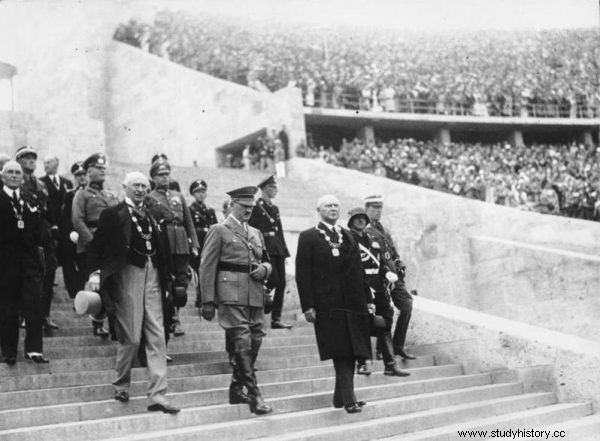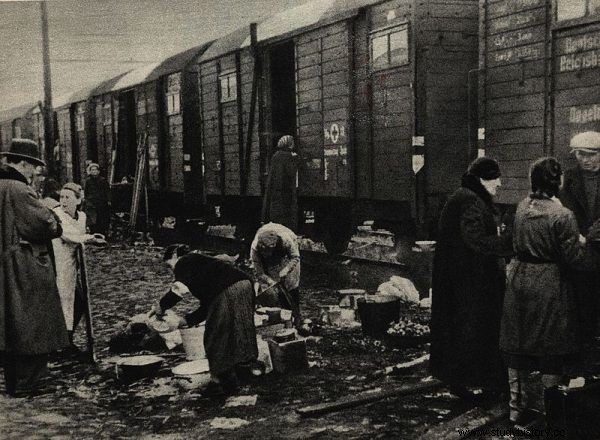Maria Kwaśniewska was not an ordinary woman. She was multi-talented, practiced seven sports - and was successful in all of them. But it was not the bronze medal at the Olympics in Berlin that brought her the greatest fame, but the brazen comment she threw in the Führer's face.
One day, one of the students of the Girls' Gymnasium in Łódź was watching her older friends who were training (with poor results) in the physical education class (with a miserable result) of the long jump. She decided to try it herself - in festive shoes and school uniform, without warming up she jumped much further than them. The coach immediately noticed her amazing talent. This is how Maria Kwaśniewska's brilliant sports career began. In the following years, she brought her many titles of Polish champion, an Olympic medal and ... a photo with Adolf Hitler.
Propaganda Olympics
Long jump, javelin throw, powerlifting, pentathlon, volleyball, basketball, running - Maria Kwaśniewska could not decide on one discipline. First, she trained at the Scout Sports Club, and from 1927 - at the Łódź Sports Club. She was looked after by coach Ludwik Szumlewski and her brother, Eugeniusz, an athlete from ŁKS.
At the age of 15, she received the award for "promising achievements" from President Ignacy Mościcki. We did not have to wait long for further successes:in 1930 she became the Polish champion in long jump, a total of 5 times - in 1931, 1935, 1936, 1939 and 1946 - she also won the title of the national champion in javelin throw . She stood on the podium many times, triumphing in every discipline for which she started. When in 1936 she traveled to Berlin for the Olympics, no one doubted that she would also bring a medal from there.

Maria Kwaśniewska began to achieve her first successes as a teenager. Nobody broke her Polish record in javelin throw in 15 years.
The International Olympic Committee awarded Germany the organization of the 1931 Summer Games. Two years later, the NSDAP took power - initially skeptical about this idea. Hitler, with his own subtlety, called the Olympics "an invention of Jews and Masons." However, he soon had to withdraw from critical comments, as his associates noticed the enormous propaganda potential of an event of this order.
The perfect games, prepared on a grand scale, were to show the whole world the wealth and prosperity of Germany. So the organization spared no effort or resources. A huge stadium with a capacity of over 100,000 people has been built in Berlin. For the first time in history, the competition was broadcast live on radio and television , and the whole thing was documented by the well-known director Leni Riefenstahl (thanks to this, the document Olympics ).
For the duration of the Games, restrictions on Jews were eased:anti-Semitic posters were removed from the streets, and the press was temporarily avoiding the subject. Sportsmen of Jewish origin were allowed to participate in the competition, and Theodor Lewald, of Semitic roots, was appointed head of the organizing committee. The smiling Hitler attended the carefully staged opening ceremony. He also often appeared in the stands to cheer the German players.
Javelin against the wind
The Polish athletics team went to Berlin with high hopes. Unfortunately, the men from the country's sports elite disappointed expectations - none of them managed to stand on the podium. The ladies did much better.
The famous sprinter of Stanisława Walasiewiczówna won silver in the 100-meter run, Jadwiga Wajsówna - in the discus throw, and Maria Kwaśniewska got the bronze medal for the javelin throw. It achieved a result of 41.80 meters - on the first attempt. As she said later in an interview with Przegląd Sportowy, she was throwing against the wind and if it were not for bad weather conditions, she would probably have improved this result:
I did more than I thought. I am very happy with this bronze medal. Before the competition, I was so scared that I couldn't hold the javelin in my hand. If it wasn't for a strong headwind, the results would be better by at least three meters.
"Głos Poranny" wrote about the feat of Kwasniewska:"In one fell swoop she proved to be one of the best javelin throwers in the world." The performance of the Polish woman was recorded and placed in her film by Leni Riefenstahl. Only two German women turned out to be better than the Polish competitor:Luise Krüger and Tilly Fleischer, who won the gold medal for herself, setting the Olympic record with a result of 45.18 meters.

Hitler, although initially reluctant to the Olympics, made regular appearances at the stadium in 1936 to cheer on the Germans. He also took part in the spectacular opening ceremony.
Meter sixty in a cap
The first screeching came during the medal decoration ceremony - the German players and the people standing around the podium raised their arms in Nazi salute. Only Kwaśniewska stood upright with her arms down ... Nevertheless, she was invited to the Hitler lodge. The Führer wanted to pay tribute personally to the Olympians.
It was there, in the presence of Joseph Goebbels, Hermann Göring and other Nazi officials, on Hitler's words:"Congratulations to the little Polish woman", Maria resolutely replied:"You are also not very tall ...". “Because he was 1.60 in the cap and I was 1.66 tall. So there was a general laugh. The German press later reported that Hitler congratulated not little Poland, but little Poland. They did not know how to get out of it anymore, "Kwasniewska recalled years later in an interview for" Rzeczpospolita ".
A souvenir of this otherwise funny event was a photo of young Marysia with the Führer. The dictator himself insisted on taking the photo, after all, the beautiful girl was hailed the Miss of the Olympics in Berlin. Let us remind you that all this happened at a time when Poland and Germany had very good relations, which began in 1934 with the signing of a mutual declaration of non-violence.

In September 1939, Kwasniewska returned to Poland to join the defenders of Warsaw as a nurse and driver. For this she was awarded the Cross of Valor.
After the Berlin adventure, the Polish Athletics Association sent Kwasniewska to the Cote d'Azur, and then to Genoa, where she was to prepare for the next Olympics. The outbreak of the war found her there. Against the advice and common sense Maria did not stay in Italy, but returned to Warsaw and took part in her defense .
She completed a sanitary and anti-aircraft course as well as a driving license. So she was directed to drive an ambulance car with which she transported the wounded. She evacuated soldiers from trenches on the Vistula River, often carrying them in her arms. For this she received the Cross of Valor. In the heat of the fighting, she did not lose her commemorative photo with Hitler. As it turned out soon - fortunately.
The photo opens the door
During the occupation, she worked at the Pod Kogutem inn in Warsaw. She lived in Podkowa Leśna. When in 1944 the Germans established a transit camp in nearby Pruszków, the so-called Dulag 121, for the inhabitants of Warsaw, who had been expelled from the capital, she did not hesitate even for a moment - she immediately went to help.
This is where the famous photography entered the game. The image of a smiling Hitler and Marysia standing next to him treated the guard at the gate as ... a pass. Thanks to this, Kwaśniewska (as she herself claimed) led out of the camp as many as 150 people, including the poet Ewa Szelburg-Zarembina and the writer Stanisław Dygat.

During the occupation, Kwaśniewska helped Varsovians placed in the Nazi transit camp in Pruszków. She was using the photo with Hitler as a pass to get the prisoners out.
After the war, the Olympic bronze medalist returned to sport. In 1946, she won the title of the Polish champion in javelin throw for the fifth time, and she also played basketball. When age forced her to withdraw from the competition, she became an activist of the Polish Athletics Association, as well as the Polish and International Olympic Committee. She was a co-founder of the Olympic Club. In 1978, she was awarded the Olympic Order. She received this award again 22 years later from Juan Antonio Samaranch as the guest of honor of the Sydney Games.
She remained active until the end of her life. Even in the 1980s (she was already over seventy then) she could be found in a tracksuit in Warsaw's Saski Park. She died on October 17, 2007 at the age of 94. Her grave is located in Powązki. Before her death, she donated her sports memorabilia, including the bronze medal from Berlin, to the Sports Museum in Łódź.
Inspiration:
The article was inspired by the novel, Confession of Hitler 2. A Honest Conversation 20 years after the war, published by Bellona publishing house.
